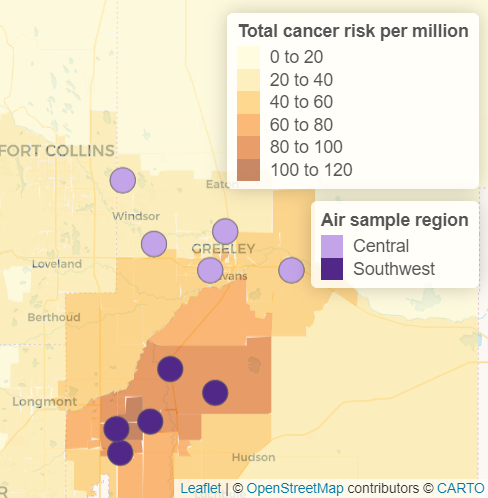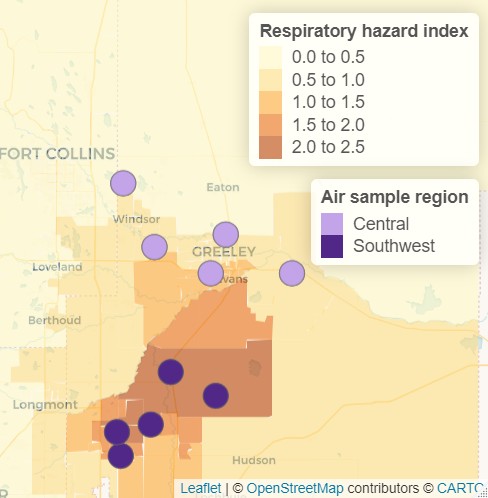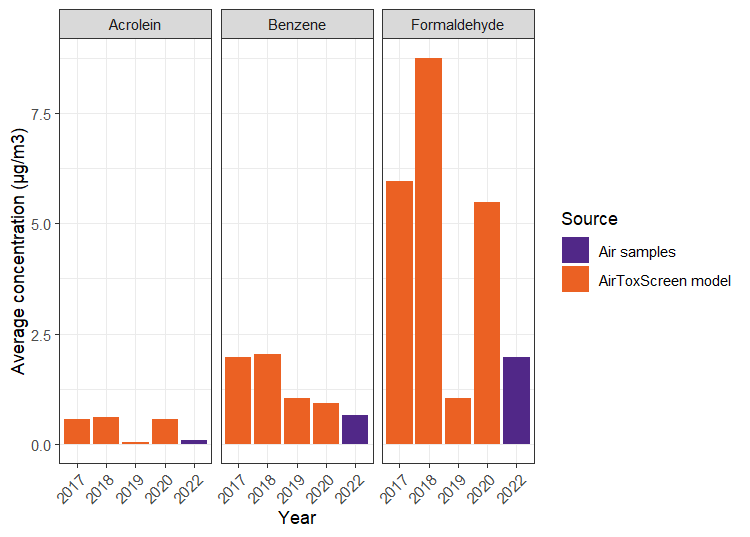Air toxics emissions from oil and gas activities
Help in your language: Free language assistance services are available to you. To request assistance in Spanish or another language, please email cdphe_apcd_outreach@state.co.us. Please include the topic and “language assistance” in the subject line. Please also link to the specific information you’d like to access, if possible, such as a web page or document.
Ayuda en el idioma de su preferencia: ofrecemos asistencia en el idioma de su preferencia, sin cargo alguno. Si desea solicitar asistencia en español o en otro idioma, envíe un correo electrónico a cdphe_apcd_outreach@state.co.us. Indique el tema y la frase “language assistance” (asistencia en otro idioma) como asunto de su mensaje. De ser posible, incluya un enlace a la información que desea consultar, como la página web o el documento.
What is AirToxScreen?
The U.S. Environmental Protection Agency’s AirToxScreen is a screening tool to estimate the potential long-term health risks from air toxics. The EPA uses computer models to estimate AirToxScreen findings. These modeled estimates rely primarily on emissions reported to the National Emissions Inventory.
The Colorado Department of Public Health and Environment reviews updates to AirToxScreen as EPA makes them available. We use AirToxScreen as a tool to identify areas that may have higher health risks. AirToxScreen is also one of the data sources to help identify and prioritize air toxics.
The estimates for AirToxScreen identified southwest Weld County as a potential area of concern. AirToxScreen 2017, 2018, and 2020 estimated high levels of acrolein, benzene, and formaldehyde in the air of southwest Weld County. Estimated levels are used to calculate potential long-term health risks. AirToxScreen 2017 and 2020 estimated cancer and non-cancer health risks that were higher than the range EPA considers to be acceptable.
Air sampling
In 2022, the department collected air samples for four weeks at ten sites across Weld County for the three air toxics estimated to pose the highest risk: acrolein, benzene, and formaldehyde.

Cancer health risk
Figure 1: Shows EPA’s estimation of cancer risk in different census tracts in the orange layer using AirToxScreen 2017. The 2022 collected air sample locations are shown in purple circles.

Non-cancer health risk
Figure 2: Shows EPA’s estimation of non-cancer risk in different census tracts in the orange layer using AirToxScreen 2017. The 2022 collected air sample locations are shown in purple circles.
The maps compare the EPA’s estimated health risks from AirToxScreen 2017 to the location of collected air samples from the department across Weld County. The collected air samples (purple circles) covered a range of estimated health risks (orange map layer).
EPA defines cancer risk using the estimated excess cancer cases attributed to that pollutant per million people exposed over a lifetime. They then compare estimated cancer risks to the EPA's acceptable risk range. This ranges from one excess cancer case in a million people to 100 excess cancer cases in a million people.
EPA defines non-cancer risk using a hazard index. This measure compares the level in the air to the EPA’s Reference Concentration. EPA’s Reference Concentrations are an estimate of continuous inhalation exposure unlikely to cause adverse health effects during a person’s lifetime. Hazard indexes above one indicate a need for further investigation.
Comparing the department’s air sample measurements to the AirToxScreen model
The department measured levels of acrolein, benzene, and formaldehyde in the southwest region of Weld County. The department’s measurements were lower than the AirToxScreen estimates for 2017, 2018, and 2020. Lower levels mean lower risk.

Figure 3: The bar charts compare the estimated average modeled ambient air concentrations from the EPA AirToxScreen Model for years 2017-2020 in orange bars to the monitored concentrations in 2022 in purple bars for each monitored pollutant, acrolein, benzene, and formaldehyde.
The estimated levels for AirToxScreen 2019 are lower than the other modeled years. This is because the EPA used a different basis of emissions and activity levels in 2019 to estimate the levels in the air from oil and gas activities. The AirToxScreen 2019 estimates were more consistent with the division's measured levels. After validating the model results to sampling data, CDPHE and EPA investigated the underlying emission inventory data used in the model and concluded that the model was overestimating emissions of formaldehyde, acrolein, and other products of combustion from oil and gas operations. The three primary issues that will be corrected in future AirToxScreen inventories include:
- Overestimating combustion-related air toxics (e.g., formaldehyde and acrolein) from condensate or storage tanks.
- EPA performs data analysis on the reported volatile organic compound (VOC) emissions from condensate tanks, and other equipment, called "Hazardous Air Pollutant (HAP) augmentation profiles." The original profile assumed that the emissions coming from condensate tanks were controlled, meaning that they were sent to a flaring device and combusted into the air. However, based on a review of operations in the ozone nonattainment area, the majority of these tanks were not controlling or flaring their emissions. EPA assigned a different HAP augmentation profile to more accurately calculate the uncontrolled emissions coming from specific condensate tanks. This changed the type and amount of pollutants released from condensate tanks.
- Overestimating emissions from well pad engines.
- The type of engine can influence what type and how much air toxics are emitted. Many well pad engines were assigned an outdated HAP augmentation profile that was meant for a different type of engine. The division provided the EPA with an updated list of engine types which EPA used to create an updated profile for these well pad engines which reduced estimated emissions of formaldehyde.
- Eliminating duplicate emissions.
- The division discovered that emissions for approximately 60 different facilities were double-counted. Most of these facilities were located in Weld County. The division and EPA worked together to remove the duplicate data, which reduced emissions.
After working to identify and fix the causes of these overestimates, CDPHE and EPA jointly estimate that formaldehyde emissions from the nonpoint oil and gas sector in Weld County are about 38% less than what was modeled for 2020 AirToxScreen. These changes are expected to reduce air toxics such as acrolein and acetaldehyde. EPA has provided a caveat related to estimated health risks from nonpoint oil and gas emissions on the AirToxScreen 2020 website. Given the large share of oil and gas production in Weld County, these overestimates were emphasized in this area. However, the emission inventory corrections will apply to larger geographic areas in future releases of the AirToxScreen model.
Next steps
The division is working with EPA to base the 2021 AirToxScreen modeling on an improved dataset of emission and activity data to better reflect the estimated risk on actual emission estimates.
Contact us
Questions? Contact: cdphe.commentsapcd@state.co.us.